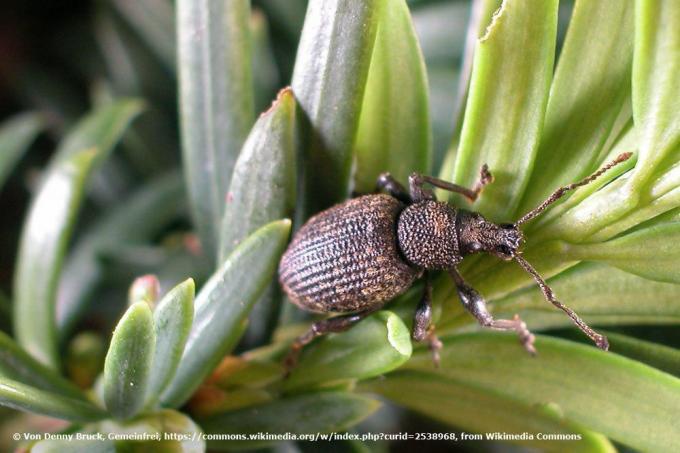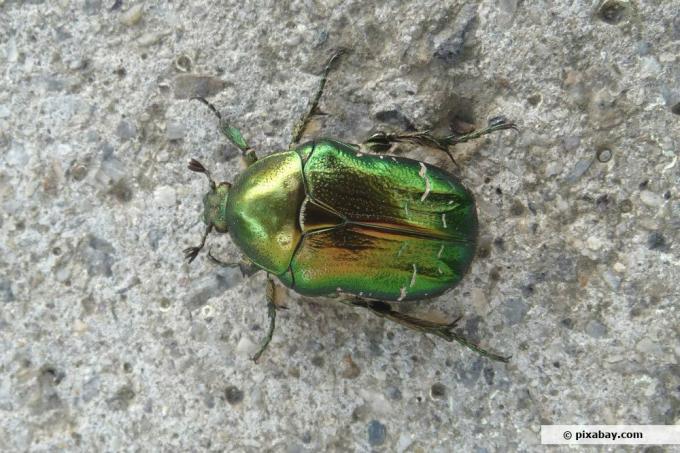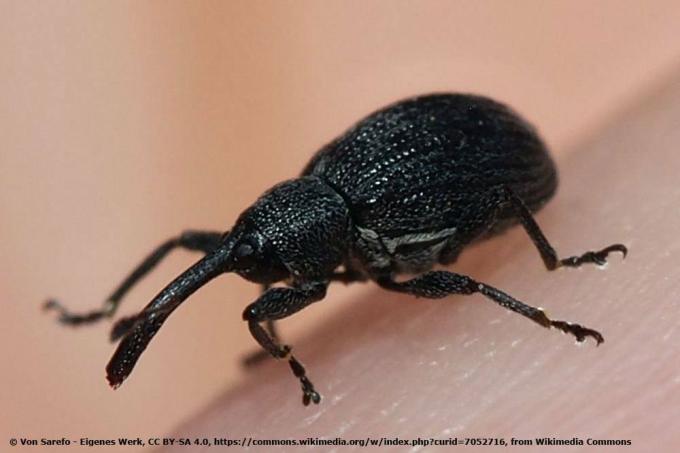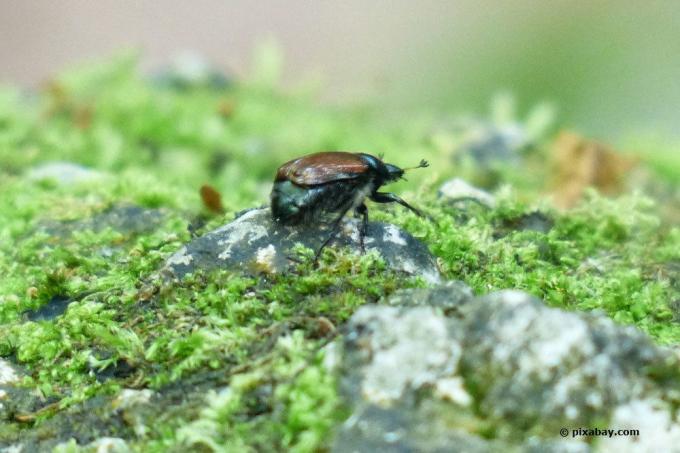
table of contents
- Roses eaten
- Suspects
- Vine weevil
- Rose sawfly
- Garden beetle
- Shiny gold rose beetle
- Strawberry blossom cutter
- Frost wrench
- Leaf cutter bees
Roses are still one of the most popular plants in your own garden today. Regardless of whether it is climbing, scented, perennial or wild roses, the plants seduce with their growth shape, flowers and smell. Many rose gardeners are afraid of pests that attack the plants and disturb their vitality. Once you know them, you can take appropriate measures to combat them.
Roses eaten
Who ate your rosebud and leaves? Like many other plants of the genus Rosa and the rose family (bot. Rosaceae), these parts of the plant are a popular food for a wide variety of insects, who gleefully attack them. Eaten roses are not a pretty sight, as they appear weak and no longer healthy. For this reason, if something eats your specimens, you should be aware of the possible suspects. Fortunately, the nature of the damage and the possible presence of the pest indicate it, which makes possible actions easier to implement. Find out which of the seven suspects is eating your leaves and buds here.
tip: If you have the opportunity to lure birds into your garden, you have extremely good protection against most of the predators. These use the insects as food and thus relieve your roses, which saves the leaves and buds.
Suspects
Vine weevil
The black weevil, actually furrowed black weevil (Otiorhynchus sulcatus), is one of the biggest pests on your roses. Not only the adult specimens, but the larvae feed on your specimens, which In addition to the leaves and buds, the roots and in extreme cases even the shoots of the roses are eaten away will. You can tell whether the black weevil has eaten your roses by the following damage:
- Leaf margins pitted (bay-shaped)
- mostly only the leaf margins
- in the evening clearly recognizable, dark beetles can be seen on the leaves
- new traces of feeding the next morning
- they only eat at night

The adult black weevil infestation is not the problem and in most cases it will go away on its own. You can simply collect the black weevils from the pink ones in the evening. To do this, wait until it gets dark and use a flashlight to locate the beetles. A bigger problem are the larvae that cavort in the ground and eat the rose roots. In the long run, this can lead to a weaker rose that dies and can no longer be saved. If you take a closer look at the soil around the plants, you will find white, quite large larvae. You can fight them as follows:
- Insert nematodes
- administer this via the irrigation water
- necessary floor temperature: 12 ° C or higher
The nematodes ensure that the larvae stop eating and slowly die, which at the same time reduces the number of adults.
Rose sawfly
If the leaves on your roses are eaten, it is often the rose petal wasp, one of the typical rose pests. The following symptoms suggest the insects:
- Small, transparent larvae can be seen from May to September
- these attack the leaves
- eat this from the underside
- they start from the middle of the leaf
- in the end only the leaf veins remain
- the holes on the leaves are not completely round
An infestation by rose petal wasps is not recorded every year. However, this can be very difficult and can even kill a vital specimen within a short time. As soon as you discover the larvae and the damage they have been eating, you should do the best you can collect, because this is the only way to fight the infestation in the long term. You can crush these too, which is why you should definitely wear gloves. You should also remove infested leaves and not yet lignified shoots. Speed counts here so that the wasps no longer eat your roses.

tip: An infestation by the white-belted rose saw wasp (Allantus cinctus) is similar. noticeable, because the feeding marks look exactly the same, only these go from the edge and not the Middle off. They fight the rose saw wasp in the same way as the rose petal wasp.
Garden beetle
Phyllopertha horticola is one of the numerous beetles that is one of the species known as the June beetle. You can recognize them immediately by their appearance, which corresponds to a June beetle with a size of eight to eleven millimeters. The damage is caused by irregularly pitted leaves and petals that look increasingly weaker over time. Sometimes you can even recognize the animals on the parts of the plant, as they are quite busy on the move. Typical flight times over the year are:
- End of May to the first week of July
- especially on warm days
- only during the day
- they rest at night
Garden beetle infestation only has a negative effect on your rose bushes and hedges as soon as they appear in large numbers. They also reproduce via larvae in the soil, which makes it easy to control the June beetles. The larvae do not harm the plants, but help to maintain the population, which in turn can be dangerous for the roses. Here you also use nematodes and try to collect as many of the beetles during the day. They can be easily caught and transported away.
Shiny gold rose beetle
Also known as the gold beetle, Cetonia aurata is one of the more pleasant companions because it does not eat the leaves and only tastes the flowers and, more rarely, buds. These can be recognized by the shiny gold color of the wing shields. They stay mainly in the flowers and eat them from the inside without actually damaging them completely. However, if you ever find a large number of beetles, proceed as follows:
- remove from the flowers in the morning
- relocate
- they fly too fast at noon
As the beetle in Germany protected you are allowed to do this not dead, but relocate without any problems. To prevent settlement, you can adjust the location in the following ways:
- Replace musty soil with fresh garden soil
- Remove rotting plant residues
- Keep compost heaps small
This way the beetle will not settle with you. Anyone wondering whether the beetle larvae are eating the roots can lean back and relax. These have no interest in the rose roots and mainly focus on rotting plant debris. Because of this, you don't need to do anything about them.

Strawberry blossom cutter
Anthonomus rubi is a relative of the vine weevil and recognizable by its black-brown color and a long trunk. The beetles are particularly dangerous for the still young buds, as they lay their eggs in them and the larvae can grow protected. The damage to the rose buds is as follows:
- Buds slightly pitted at the edges
- no longer open
- hang down
- fall off the stem
The interface of the bud, through which the beetle interrupts the supply of nutrients, is characteristic of the strawberry blossom piercer. This looks as precisely cut as with secateurs, which amazes many gardeners. The only remedy for this is to use neem-based preparations that are applied around the roses. You should remove the infected and already fallen rosebuds with the residual waste or burn them so that the larvae cannot spread any further.

Frost wrench
The frost spider (Operophtera brumata) is a moth whose larvae eat the flowers, leaves and buds of roses. This can be recognized by traces of feeding that run in an arc over the leaves. In addition, the clearly recognizable caterpillars indicate the infestation, which you can easily collect. If the infestation is very large, the leaves become skeletonized. Here it helps to sprinkle neem powder in the spring and pour it abundantly. This strengthens the plant, which means that infestation is no longer possible. Alternatively, you can make a spray from rapeseed oil and water during the infestation and apply it directly to the roses.

tip: Rose or hedgehog moths have similar effects on the rosebuds and leaves, but differ only slightly in terms of damage. Proceed in the same way here so that your specimens are no longer eaten by the pests.
Leaf cutter bees
Last but not least, the leaf cutter bees, better known as wallpapering bees, should be mentioned. These insects are not Pestsbut about wild bees that live solitary. They use parts of the rose petals to build nests and eat them cleanly without making them susceptible to disease. The damage caused by bees eating can be recognized by circular holes that start from the edge of the leaf. The leaf remains healthy despite the damage and therefore you don't have to do anything against the bees. Neither should you, because you are at risk for a variety of reasons:
- environmental pollution
- Habitat loss
Because of their endangerment, they are particularly vulnerable in Germany protection and may not be killed or captured. They are also important pollinators of numerous plants in your garden and one of the most important for alfalfa (bot. Medicago sativa). Bees of the genus Megachile only use as many leaf pieces as they really need and only cause very little damage. You should therefore be happy about these visitors in your garden.

tip: In rare cases, your rose buds and flowers may be missing due to browsing by deer. The animals taste the roses all too well and as soon as you live near a wooded area or far away from urban centers, your pink can suffer from it.

